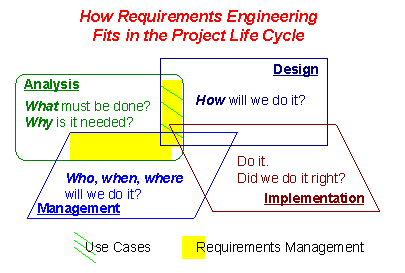Requirements Engineering
![]()
Requirements Engineering
![]()
|
|
|||

|
|||
 Glossary
Glossary
ActorA user (person or external system) who initiates the use case. ElicitationFinding the right people (stakeholders or SMEs) to talk with, conducting interviews and JAR/JAD sessions, and capturing the the requirements. Functional RequirementA requirement that specifies an action the system must be capable of performing. (As opposed to a Non-functional Requirement.) JAR / JRP and JADJoint Application Requirement (JAR) session. Also known as a Joint Requirement Planning (JRP) session. Non-functional RequirementA requirement that specifies an aspect of the system that does not directly relate to behavior, such as reliability, maintainability, and performance. (As opposed to a Functional Requirement.) Release ManagementAn activity that defines the contents of iterations and releases; also known as Iteration Planning. This is typically driven by requirements' priority, but other factors can come into play as well. RequirementA capability and objective to which a system must conform. A requirement should be necessary, testable, feasible, clear, and traceable. Most requirements are dynamic; they change over time. Requirements AcquisitionSee Requirements Capture. Requirements AnalysisThe process of studying a business's processes to determine the business needs and functional requirements that a system must meet. Requirements CaptureFinding, identifying, obtaining, and determining requirements. This activity involves understanding the customer's business needs. Requirements DiscoverySee Requirements Capture. Requirements GatheringSee Requirements Capture. Requirements EngineeringA systematic approach to: Requirements ManagementThe process of: SMESubject Matter Expert. A personal who is knowledgeable about a particular topic. StakeholderA person who holds a stake, or has an interest in, the particular subject. Systems AnalysisSee Requirements Engineering. User StoryA user story is sometimes used instead of a use case. Here is a sample: As a supervisor, I want to review my staff's timesheets and approve or reject them so that they can be paid, and time accounting and payroll are accurate. Use CaseA sequence of actions that occur in the system, upon an actor's request, that produce an observable result. Use cases are part of the Unified Modeling Language (UML) and are used in most object-oriented software development processes such as Rational?s Unified ProcessTM and Select?s PerspectiveTM. See Use Case Model. Use Case Model
Use Case NarrativeA descriptive narrative of a behavior or set of behaviors triggered by events sent to the system by human user(s), other systems, hardware components, or an internal clock. |
|||
QUOTES
|